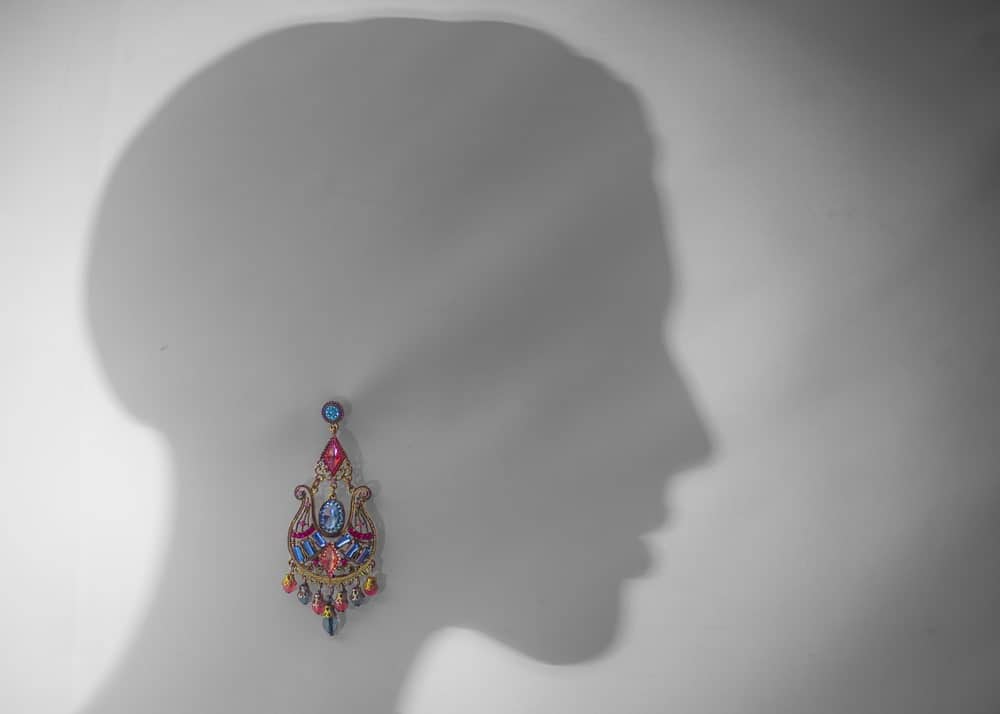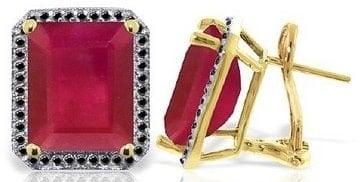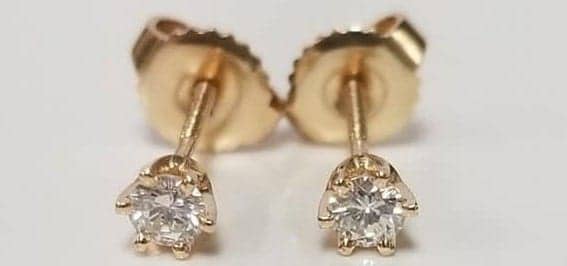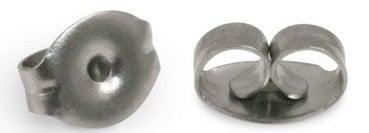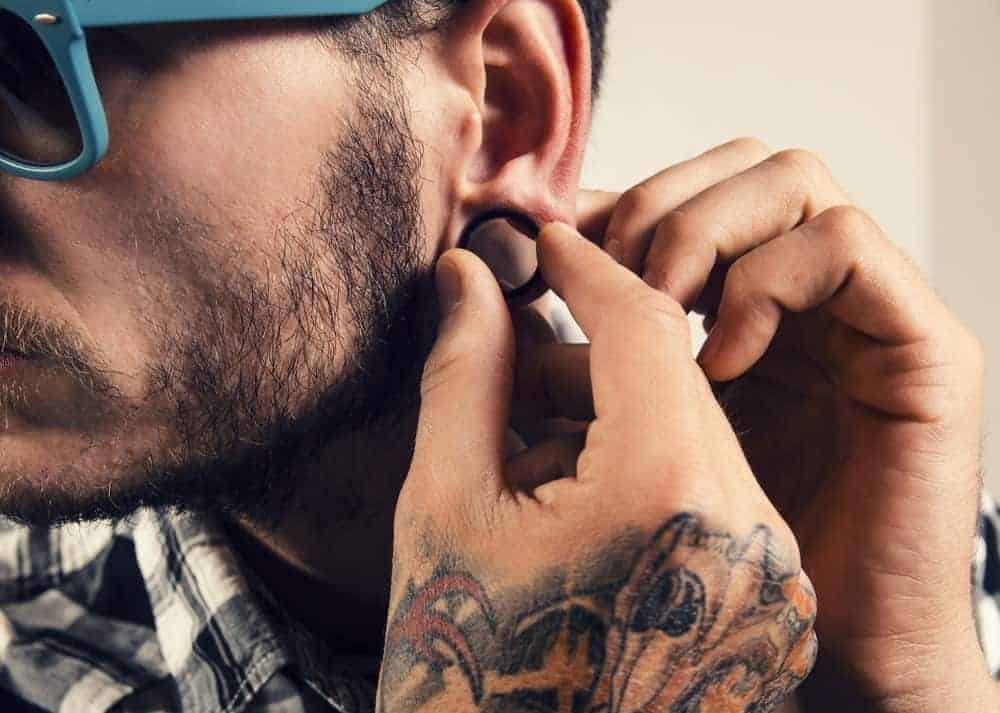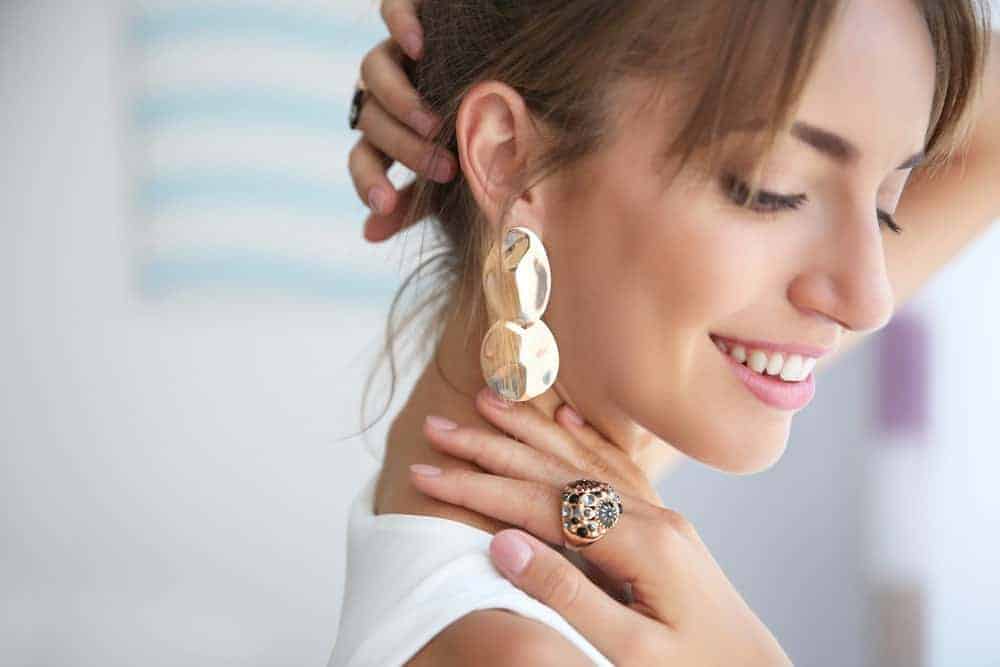Keep those earrings in place and check out the different types of earring backs for your pierced ears. Find out which earring backs or push backs are the easiest to slip on, the most durable, the cheapest, and the most secure for keeping your earrings firmly in place.
Toronto’s Ira Carlin a.k.a. The Earring Doctor invented the earring back plastic disc in 1984. Known as “Le Disc,” this plastic backing caused an online debate in 2015 on whether it should be worn off the earrings. Carlin himself settled the Great Earring Debate when he clarified that people should “leave it on.”
The plastic earring backs served a functional purpose which was to stabilize the earrings when it’s too heavy for the ears. Jewel experts also explained that “the larger the earring back, the more stable and secure the earring wears.” Plus, the plastic protection keeps those gaping earholes from getting worse.
Contents
Types
Clip Earrings
These earrings are made for people who do not have pierced ears. They usually consist of a clip attached to a hinge, which grabs the earlobe so the earring stays in place. Sometimes, people wear this type of earring even though their ears are pierced, the most noticeable example includes the wearing of costume jewelry, which tends to be quite large and somewhat heavy. Extra-heavy pieces can damage or even stretch your earlobe because of their weight, but clip-on earrings prevent that from happening.
French Clips
Source: QP Jewellers
Also called Omega backs, French clips can be worn with both pierced and non-pierced earrings. They have a clasp that grips the earlobe firmly, and they are commonly found in earrings that contain gemstones. With some French clips, there is a screw that attaches to the back even more firmly. It essentially has a post attached to the top section of the earring and a clasp with a hole in it and that post goes through once you close it.
French Wires
Also called fish hooks, they are usually attached to the end of fairly heavy earrings, like teardrop-shaped earrings, and the weight of the earrings keeps them in place. The backs are curved wire hooks that fit through your ear, but which don’t require any type of back because they are long enough to do the job by themselves. In addition, these types of wires are usually fairly long, because this is the best way to make sure they keep the earrings in place.
Jumbo Earring Backs

Usually made out of some type of plastic, these are large round backs that look like discs, and as soon as you put them on, they flatten the earlobe and make the earring lay more evenly. Many people wear these instead of other types of backs because of the way they make the earrings look.
In addition, these are some of the most comfortable earring backs to wear because they are normally made out of plastic, and the clear plastic ones have an added benefit of being invisible, making it easier to wear them with earrings of all sizes, shapes, and colors. They also come in rubber instead of plastic in many instances.
La Pousette Backs
Source: Etsy
These backs are specially designed with a post that has an indentation in it, so even if the back happens to slide down the post, it will get stuck there and not fall off. The back has a spring-loaded mechanism that is pressure activated, and the way it works is simple. You squeeze both ends of the back at the same time and it opens up to allow insertion onto the post. If you want to take the earrings off, simply squeeze the ends again and pull it over the post, and it will come off immediately.
Latch Backs

Used mostly on heavy earrings such as hoops and dangling ones, these backs have a hinged post which attaches to a metal catch. The shape of the catch varies according to the style. The catches on latch backs are usually loop-shaped or U-shaped, so the back of the earrings consists of a basic look – a short post that fits neatly into a loop of some type.
Lever Backs
Source: Etsy
Just like latch backs, these backs consist of a hinged post and metal catch that attach together, and the catch comes in various types. Although latch backs and saddlebacks usually have loop-shaped or U-shaped catches, the catches on lever backs are usually made out of a lever and spring that clasp together to keep the earring on.
This type of earring back essentially makes a loop and has a small hole at the end of the loop, which is where the rest of the earring (the gem, and much more) is attached to, and the loop attaches together at some point.
Push Backs

These are also called the post or butterfly backs. These are very standard earring backs, especially when it comes to basic stud earrings. They are butterfly-shaped and made out of thin wire, with a small hole in the middle that the earring fits into, giving it a very snug fit. You can also buy just the push backs if you like, which is common because it is easy to lose these types of earring backs.
Saddlebacks
Source: Etsy
Saddlebacks are similar to latch backs and lever backs because they consist of a hinged post and metal catch that enclose together, with the catch being available in various types. In saddlebacks, the catch is usually either U-shaped or loop-shaped, however. The hoop usually sits on the top part of the earring and fits inside of a small hole, which keeps the earring together.
Screw Posts
Source: Etsy
Screw posts are similar to push backs, and they are often used in more expensive studs, such as diamonds because they make the earring more secure. A screw post has a winding groove along with the post that screws on and off, and because it screws on tightly, it won’t fall off or get loose.
When you look at it, it can look like a regular pushback, but instead of pushing it in to get the earring to close, you screw it in instead, meaning it is a little more secure than a regular push back.
Materials for Earring Backs
Gold Backs

Gold is one of the most important metals in existence today, and with good reason. Not only is gold very attractive, but it is also very strong and therefore, it is perfect for earring backs. Gold that is 24K is considered “pure” gold, and with jewelry pieces such as earring backs, this type of gold is normally mixed with alloys, which in effect lowers its carat rating; for example 10K, 14K, 18K, or 22K.
Lower carats always contain more copper, silver, palladium, or other types of base metals, with copper being the most common base metal used today. Earring backs made of 18K yellow gold have a nice warm color, and 14K yellow gold is lighter and brighter than other types of gold.
Gold is also popular because they ensure safety and durability for a lifetime, making it the perfect ingredient for the making of earring backs.
Plastic Backs
Source: Etsy
The plastic used in earring backs is usually soft, clear plastic, and the backs can come in many sizes and shapes. They are soft and flexible, but still sturdy enough to do the job they are meant to do.
Plastic earring backs are sometimes very small, such as those used for fish hook-type backs, or very large, such as those used for extra-large earrings. The plastic backs are also good when you want a subtle look that doesn’t show the back at all, which means the earring itself is more emphasized and noticed.
Rubber Backs
Source: Etsy
The earring backs made of rubber are made like those in plastic, and both of them offer the advantages of being made in a variety of sizes and being clear so that they are barely noticeable. The rubber used is a sturdy type of rubber, but still flexible enough to handle the earrings with ease.
In fact, rubber earring backs and plastic backs are very similar, and often the wearer will never know which materials the earrings are made of. They are also a very inexpensive type of earring back, making them perfect for those who are in search of attractive, but inexpensive jewelry.
Silver Backs
Source: Etsy
Although not always as durable as other metals, silver and sterling silver are very often used in the making of earring backs. The most popular type of silver is silver that is alloyed at 7.5% to copper, and this type of silver is often plated so that it ends up with a bright, shiny appearance.
One of the reasons sterling silver is so popular is that it can be easily made into a variety of shapes and designs, thanks to its softness and flexibility. Its cons include the fact that it is easily tarnished and isn’t usually as strong as titanium, gold, and stainless steel.
However, when you’re looking for inexpensive jewelry of any type, it often has silver or sterling silver as its main component, so these types of earring backs are always affordable.
Stainless Steel Backs
Source: Jewelry Supply
Also called surgical steel backs, these are very strong earring backs that have a hypoallergenic quality to them. Stainless steel is essentially a combination of various alloys and grades, and one of the most interesting characteristics of stainless steel is that it is also used in the biomedical field for various applications, mostly because of its strength. In addition to earrings, if you purchase jewelry for any type of body piercing, it is usually made out of stainless steel.
Some Interesting Facts about Earrings
They’ve Been Around for a Very Long Time
Earrings are not exactly a new product. In fact, archaeologists have dug up earrings as old as 2,000 years old, so they’ve been around for a very long time. Even back then, there were cults and religions that included the wearing of ear jewelry as part of certain ceremonies, especially coming-of-age ceremonies.
Some coming-of-age traditions, in fact, included the piercing of ears, and apparently, even the Persian Empire soldiers wore earrings when they went into battle. For at least 2,000 years, earrings have been a part of the lives of people all over the globe.
Men Have Loved Earrings, Too, for Centuries
Several centuries ago, more men than women wore earrings. In the Americas, before the white man arrived, the Native American men wore earrings quite frequently, not only in certain ceremonies but also in everyday life.
In fact, at one point in history, it was very common for poets to wear hoop earrings, and it is widely thought by most experts that William Shakespeare himself wore these types of earrings. Although both men and women have worn earrings throughout much of history, it is certain that men wore them first, and for a much longer time than women have worn them.
Self-Made Piercings Used to Be the Norm
In the late 1950s, pierced ears became very popular, but it wasn’t until a decade or so later that most jewelry stores started to offer piercing services. Therefore, many teenage girls sought to pierce their ears on their own.
One common practice was to hold the earlobe between two ice cubes until it went numb, then using a needle to make a hole in the earlobe.
Some people would hold a potato or other item in the back of the earlobe for the needle to find a stopping point, but even though they usually placed the earrings and needle in some alcohol to “sterilize” them, this is not exactly the cleanest way to pierce your ears.
Having your ears pierced by the professionals is always your smartest option, and fortunately, facilities that offer this service are extremely easy to find these days.
Earrings Have Been Used to Symbolize a Lot of Different Things
The wearing of earrings has been used to symbolize membership in certain tribes, a person’s sexual preference, certain religious beliefs, and even social status in many cultures. One example of this phenomenon is a pierced earlobe on a sailor, which typically means that sailor has accomplished something special, including crossing the equator or the completion of a trip around the world via ship.
This makes the sailor very popular and well known, but it is just one example of how a simple earring can make a bold statement about the person wearing it.
On a similar note, pirates wore earrings because they thought they could protect them from harm and evil. They also thought it could prevent seasickness, and they were often worn as a talisman for protection. In addition, if a man died while aboard a ship, people often attached an earring to the body. This would help cover the cost of transporting that body to its next destination.
You Can Pierce More Than Just Your Ears
Today’s piercing facilities offer far more than just ear piercings. You can also have other areas pierced, including the lips, eyebrows, tongue, genital areas, nipples, belly button, and just about anywhere on the facial area.
Even if you decide you want your ears pierced, there are numerous areas on the ear that can be pierced. This includes not only the earlobe, but also the top part of the ear that contains a lot of cartilage, and various areas inside the ear.
Again, all of these areas require that you trust only a true professional for piercing because only they will have well-trained technicians who know just what to do to keep the procedure safe, as well as the tools, equipment, and materials needed to keep everything clean and sterile during the procedures.
Sleeper Earrings Used to Be the Norm
In the 1840s and 1850s Europe, women changed their hairstyles to styles that covered the earlobes, and therefore, many women stopped wearing earrings altogether. Because of this trend, women who already had pierced ears didn’t want the holes to close up, so they used to wear very simple, basic earrings when they slept to keep the holes intact.
These earrings were called sleepers, and they were very popular until women started wearing other types of hairstyles.
Earrings Were Not Always as Popular as They are Now
The popularity of earrings has gone up and down throughout the ages. In the 1950s, earrings were so unpopular that it wasn’t even considered “proper” for women to wear them. During timeframes such as this, if women did wear earrings, they were always clip-on earrings, because it was considered tacky to get your ears pierced.
In the early 1900s – again, mostly due to hairstyles that emphasized hair placed on top of the head – earrings were popular, so what happened in the next 50 years to change that, no one knows. It is just obvious that there were many times throughout history where earrings were very popular or turned people off completely, each for a variety of reasons.
Be Careful with Pearl Earrings
Gemstones and precious metals will last forever, but this is not so with pearls. Pearls are an organic type of stone, and as such, they tend to start decaying after about 300 years. This doesn’t have to concern you right now, but if you purchase a pair of pearl earrings and hand them down to a daughter or granddaughter, it may prove disastrous generations from now.
Of course, pearl earrings are not likely to wane in popularity anytime soon, so buying a pair is still a good idea.
They Are Attached to Many Superstitious Beliefs
Throughout the ages, earrings have been associated with many types of superstitions, including the following.
- Common beliefs have included beliefs such as gold earrings that can cure headaches and emerald earrings can strengthen weak eyes.
- Piercing ears used to be considered a punishment for eavesdropping, while the earrings were intended to be a consolation for the pain that was suffered. It was thought that the bigger and more expensive the earrings were, the bigger the consolation.
- The first earrings were likely a way to keep out evil spirits because it was thought that these spirits could enter any opening in the body and wreak havoc on a person’s life.
- Some people believe that if you get your lover’s name tattooed somewhere on your body, that is enough to jinx the relationship. This one, however, is certainly not always true.
Most superstitions are partially true and partially false, but they are nonetheless a lot of fun to learn about.
Earrings Can Change the Look of Your Face
Earrings can dramatically change the look of your face and make it look a lot different. Below is a general guide regarding what types of earrings you should wear.
- If you have a long face, you should wear earrings that are small and round, such as studs, because they accentuate the shape of your face and make it look more attractive.
- If you have a face that is square-shaped, you should wear dangling earrings because the earrings make your face look more shapely.
- If you have a face with small features, large earrings will work best for you, and if the earrings are too large, it is best to wear them without a necklace. These types of earrings balance out the face and give it a great shape.
- If you have a round face and a short neck, long earrings will look best on you, because they elongate the face and make it look longer and prettier. The rounder your face is, the longer the earrings can be.
- If you want your facial features emphasized, try wearing earrings that have geometric shapes. If your features are already angular, you should stick with earrings that are oval or round in shape. These earrings are great for people who have smaller-than-average eyes, noses, or lips.
- Young women, especially teenagers, can wear any type of earrings they want, while older and mature women should always stick with earrings made of stones or precious metals.
- Blond-haired women should wear earrings that are light in color, while brunettes are able to wear earrings in bold and bright colors with no problems. As a general rule, the lighter your hair is, the lighter the earrings should be.
- Earrings made of wires should be worn with caution on older women because often these types of earrings make a person look even older. If wires are part of the earring, you may be able to get away with wearing them, but if that is all the earrings are made of, it’s best not to wear them if you’re over a certain age.

